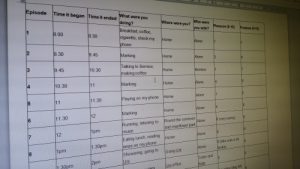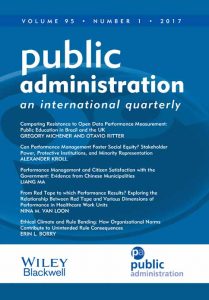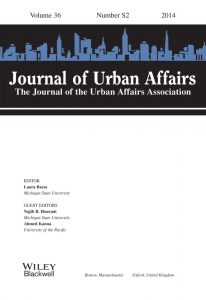My Happiness Experiment

A bit of my Day Reconstruction Method (DRM) Diary
Last month I wrote about a new method of measuring happiness, or ‘subjective wellbeing’ as sociologists like to describe it, in our daily lives (you can read that post here if you haven’t already). My starting point was that most of us rely on our ‘evaluative self’ at the expense of our ‘experiencing self’. This means that when we are asked if we are ‘happy’ in our lives/job/relationship/location etc (or if we reflect on this question internally), we too often resort to generalisations which often have little relation to how we experience our lives, day-by-day or hour-by-hour.
Paul Dolan, in his book “Happiness by Design” points to a number of methods which might engage our usually-neglected experiencing self to find out how happy we are on a daily basis; to identify which activities maximise either pleasure and/or purpose; which people make us happier in different contexts; and thus, what kinds of adjustments we might make to our daily lives in order to maximise happiness. One of these methods is the Day Reconstruction Method, or DRM.
So over several days in early January, I used the DRM, first created by proposed by Danny Kahneman et al, to try and break down my activities into smaller chunks which I could assess to find out exactly what makes me happy in terms of purposefulness and pleasure. It’s basically a diary with a specific purpose.
Some of the results were pretty obvious, some were fairly surprising. The point is that having this feedback has given me some kind of basis for making improvements in my routines. We are such creatures of habit, and we reflect so little on what we actually do in our lives, that I thought it was worth a go. Some of the results are a little personal, and I’m not going to share them (sorry, dearest reader!) but here are some that I will:
- Variety is the spice of life. I had to do some very boring marking of exam scripts at Uni. Usually when I have a tedious task like this my approach would be to lock myself in a room for a day to “Get my head down”. But I actually found that when I mixed up tasks, and locations, between my home, office and a cafe, I got more done and my levels of pleasure, whilst still low (marking is always a drag), weren’t quite so bad.
- Cooking and exercise make Jack a happy boy. Few activities produce both pleasure and purpose, most activities are skewed one way or another (e.g. changing nappies – purpose; watching football – pleasure). But cooking and doing exercise (in my case, running and doing yoga) seem to be both pleasurable and purposeful, for me at least, which is why I do both of these activities everyday.
- Diminishing Returns. Even if certain activities sound like a great idea, they all get boring after a while and pleasure/purpose starts to tail off. For me this includes lie-ins, reading, playing games, working on an essay, watching films, even (dare I say it) drinking beer.
- Smartphone games and social media are a waste of time. I already kind of knew it, and now the DRM has given me proof. I might get a certain amount of pleasure from these things, at the expense of much purpose. That’s fine. The problem is that these activities are addictive and the law of diminishing returns kicks in. So, to my favourite shoot-em-up smartphone game “Sky Force”, it’s been a fun few months, but you have to go. Adios!
- The Hawthorne Effect – This refers to the phenomenon where participants who know they are being observed in social experiments often act differently to how they would in a natural environment. Likewise, my own behaviour changed when I knew that I was, in effect, going to be the subject of my own research. I wanted to maximise the pleasure and purpose of every hour of each day, and so I noticed that I was actively trying to tweak my activities with this in mind.
If this was a real piece of social research, the presence of the Hawthorne effect would be a major weakness which wouldn’t get past peer-review. But it isn’t. It’s a bit of fun, which has proved useful to me.
It’s quite amazing how much of lives – the precious days, hours, and minutes we are blessed with – we spend on auto-pilot, rarely stopping to see what makes us happy and what doesn’t. This can, on the one hand, leave us with low levels of purpose, stuffing ourselves with immediate gratification yet still feeling our time is wasted and fruitless (people Dolan terms “pleasure-machines”). On the other hand, we can be left with low levels of pleasure, obsessed with ‘deliverable outputs’ at work, but having a life which is a bit boring and antisocial (people Dolan calls“purpose-engines”).
For each of us, the problems and solutions in terms of maximising our subjective wellbeing will, of course, be different. But the first step, for anyone, is surely to obtain information which we can use to then devise appropriate improvements. As people, it’s healthy to reflect. And as social scientists, it’s quite refreshing to view ourselves as potential research subjects as well as researchers.
Hiring a life coach is expensive. Doing the DRM is a cheap and fun way to have a go at being your own.
Dolan, P (2014) Happiness by Design: Finding Pleasure and Purpose in Everyday Life. Penguin.






